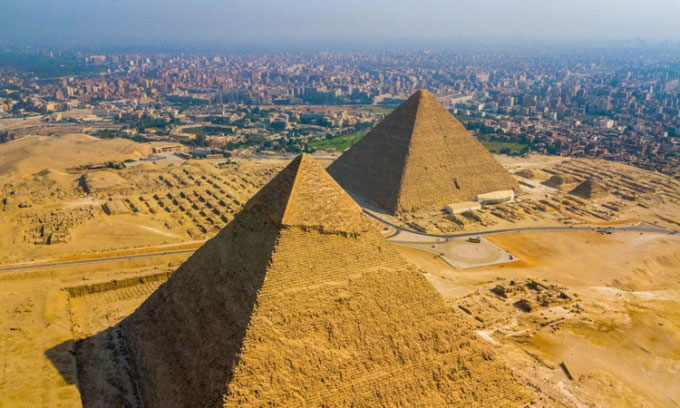Why did the Egyptian pharaohs stop building pyramids?
After more than 1,000 years of using giant pyramids as burial sites, the pharaohs turned to underground tombs for a variety of reasons.
For more than a millennium, Egyptian pharaohs built pyramids and were often buried beneath or within these great structures. Pharaoh Djoser (2630 - 2611 BC) started building the step pyramid at Saqqara and pharaoh Ahmose I (1550 - 1525 BC) built Egypt's last royal pyramid at Abydos.

The iconic pyramids were built by many pharaohs as tombs over 1,000 years.
These symbolic pyramids represent the power and wealth of the pharaohs and promote religious beliefs. So why did they stop building pyramids not long after the New Kingdom of Egypt (1550 - 1070 BC) began?
Egyptian pharaohs seem to have stopped building pyramids after the reign of pharaoh Ahmose. Instead, they were buried in the Valley of the Kings near the ancient Egyptian capital Thebes, now Luxor. The oldest royal mausoleum in the valley was built by pharaoh Thutmose I (1504 - 1492 BC). Pharaoh Amenhotep I (1525 - 1504 BC) may also have built a tomb here, but scientists are still arguing about this.
Experts are not sure exactly why the pharaohs stopped building pyramids. However, security concerns could be a cause. "There are many theories, but since the pyramids were frequently looted, hiding the royal tombs in a remote valley, carving tombs in the rock and possibly having a lot of cemetery guards, certainly play some role," explains Peter Der Manuelian, a professor of Egyptology at Harvard University.
"Even before they stopped building the pharaoh's pyramid, the Egyptians stopped booking burial chambers underneath this structure. The last royal pyramid at Abydos had a burial chamber at the back, about some distance away. 0.5km, deeper in the desert," said Aidan Dodson, professor of Egyptology at the University of Bristol.
A record from Ineni, who was in charge of building the tomb of Thutmose I in the Valley of the Kings, may hold important clues. "I supervised the excavation of the king's cliff tomb alone - no one saw, no one heard," Ineni wrote. The memo clearly shows that secrecy is a major concern, said Ann Macy Roth, a professor at New York University.
The natural topography of the Valley of the Kings may explain why it is a popular site for royal tombs. It has a peak called el-Qurn, which looks quite like a pyramid. Therefore, all royal tombs built in the valley can be considered as being placed under pyramids, says Miroslav Bárta, an Egyptologist at Charles University. For the Egyptian pharaohs, pyramids were important because it was the place where "ascension and transition into the afterlife", according to Mark Lehner, president of the Association for the Study of Ancient Egypt.

The pharaohs may have chosen to place the tomb in the Valley of the Kings to be better hidden from grave robbers.
The terrain of Luxor, the capital during the New Kingdom of Egypt, may also have contributed to the pharaohs' stopping pyramiding. The area has limited space and is too rough, Dodson said. In other words, Luxor is too small and causes many architectural difficulties, so it is not suitable as a place to build a new pyramid.
The religious changes during the New Kingdom of Egypt emphasizing the placement of underground tombs may also be the reason why the great pyramid fell out of favor. The underground tombs at the Valley of the Kings also fit this.
While the pharaoh stopped building pyramids, wealthy individuals continued. For example, the 3,300-year-old mausoleum in Abydos belonging to a man named Horemheb has a 7-meter-high pyramid at the entrance, archaeologists announced in 2014.
During the first millennium BC, pyramiding also became common in Nubia, what is now Sudan, and parts of southern Egypt. Nubia has pyramids for both royalty and individuals, the exact number of which is unknown. The rulers of Nubia only stopped building about 1,700 years ago.
- 25 unexpected facts about the Egyptian pyramids
- Theories about how to build pyramids in ancient Egypt
- The ship brought Egyptian pharaohs to the afterlife
- How was the Egyptian pyramid built?
- Construction errors caused the Great Egyptian pyramid to deviate
- Discover hundreds of ancient Egyptian pyramids, hidden deep beneath the ground
- Find 2 missing Egyptian pyramids
- Unique pyramids are not located in Egypt
- Pyramids and things you do not know!
- Is the Egyptian pyramid built up from the inside out?
- Six mysterious archaeologists died after opening the ancient Egyptian coffin
- It will cost $ 5 billion to build an Egyptian pyramid
 Discovered an ancient centipede fossil 99 million years old
Discovered an ancient centipede fossil 99 million years old Discovered bat-like dinosaurs in China
Discovered bat-like dinosaurs in China Discovered a 200-year-old bronze cannon of the coast
Discovered a 200-year-old bronze cannon of the coast Discover 305 million-year-old spider fossils
Discover 305 million-year-old spider fossils